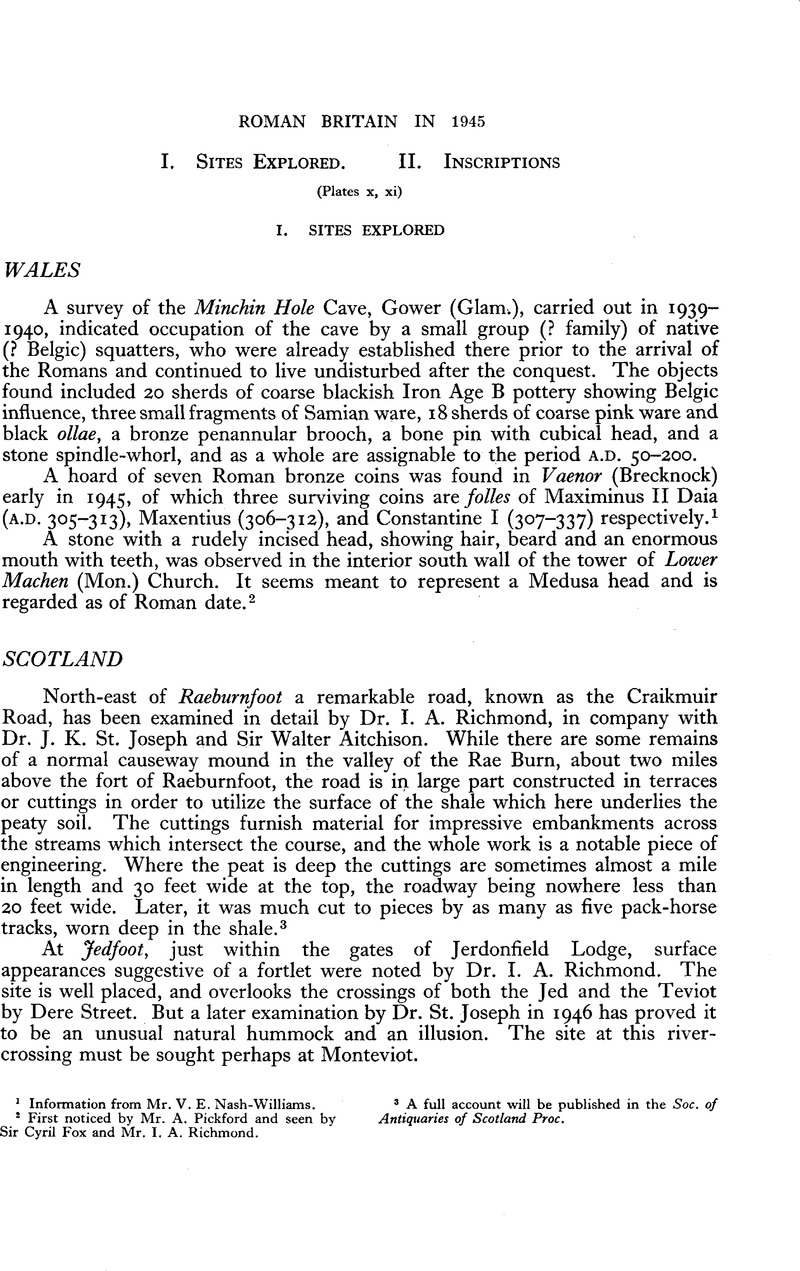No CrossRef data available.
Article contents
Roman Britain in 1945
Published online by Cambridge University Press: 24 September 2012
Abstract

- Type
- Review Article
- Information
- Copyright
- Copyright © 1946. Exclusive Licence to Publish: The Society for the Promotion of Roman Studies
References
1 Information from Mr. V. E. Nash-Williams.
2 First noticed by Mr. A. Pickford and seen by Sir Cyril Fox and Mr. I. A. Richmond.
3 A full account will be published in the Soc. of Antiquaries of Scotland Proc.
4 Information kindly sent by Mr. Norman Smedley, Curator of Doncaster Museum, which has acquired the hoard.
5 Antiquity 1945, 11 ff. Mr. O'Neil here suggests that the interrupted linear earthwork facing SW known as Grey Ditch, which runs from the hill fort on Mam Tor across Bathamgate some ¾ mile SW of Anavio and seemingly covering the lead-mining area, may be a late sub-Roman British frontier, but this requires proof.
6 The Committee was formed in 1945 under the chairmanship of Councillor J. W. F. Hill by the enterprise of Mr. F. T. Baker, Curator of the Museum, and Mr. Graham Webster, the supervisor of the field-work, Mr. I. A. Richmond and Mr. C. F. C. Hawkes acting as advisers.
7 We are indebted to Mr. Graham Webster for the plan shown in fig. 11.
8 Assoc. Arch. Soc. Reports xxi, 48, with coloured plan (= Arch. Journ. xlix, 258); JRS xv, 227. Chequered pavements like those found in 1884 have turned up again in 1945.
9 No site has been examined scientifically; only one, found some years ago, is recorded to have had three successive clay floors. A large collection of pottery, etc., from this area made during the last fifty years and including some forty complete vessels, has been presented by Mr. Warby to Wisbech Museum.
10 Information from Mr. E. J. Rudsdale, of Wisbech Museum, which has acquired the hoard, citing Miss Anne Robertson, who is publishing it. There seems some doubt whether the hoard of some 655 antoniniani and 5 denarii of Postumus (302), Marius (6), Victorinus (133), and Tetricus I (5), also dated to A.D. 271, is not actually a part of the 1938 hoard, though it is said to have been found in October, 1941, a few yards from Long Lots Drove Crossing on the north side of the railway line about ½ mile east of the 1938 hoard, and so in West Walton parish. (Papers of the Norfolk and Norwich Arch. soc. xxviii, 107 ff.; Num. Chron. 1943, 101; JRS xxxii, 110). Early in 1946 Wisbech Museum received fifty coins said to be from the hoard ‘on he Smeeth’, a description which might fit either hoard.
11 Information from Mr. Basil Brown.
12 Probably the Iron Age re-fortified by the Danes— see Hist. Mon. Comm. Inventory Essex IV, xxix, 32 f., and VCH Essex i, 289.
13 The work was carried out by a committee under he chairmanship of the Mayor of Southwark.
14 E. J. Hildyard, Nottingham Arch. Soc. Tenth Annual Report, 1945 (1946), 9 ff.; Hawkes, C. F. C. and Jacobsthal, P., Antiqs, Journ. xxv, 1945, 117 ff.CrossRefGoogle Scholar, where much earlier finds are recorded, including a fine Celtic bird-brooch of the mid-third century B.C.
15 Information from Mr. F. Cottrill, of Leicester Museum.
16 The site was discovered by Mr. L. Walrond, the work being carried out, by kind permission of the owners, Messrs. H. and L. Cook, by Mr. H. S. L. Dewar and C. A. R. Radford under the auspices of the Somerset Archaeological Society.
17 Information from Mr. R. Atkinson, who carried out the work for the Ashmolean Museum. It will be published in Oxoniensia x.
18 Information from Mr. M. S. F. Hood and Mrs. Walton, who carried out the work. For Lowbury, see D. Atkinson, The Romano-British Site on Lowbury Hill (Reading, 1916).
19 Information from Mr. W. F. Grimes, F.S.A.
20 Information from Mr. Shepherd Frere, F.S.A.
21 Information from Mrs. Audrey Williams, who was in charge of the work, as in 1944.
22 VCH Kent iii, 42, pl. viii.
23 Information from Mr. B. H. St. J. O'Neil.
24 When measurements are quoted the width precedes the height. The following abbreviations are used in addition to the usual ones, with superscript figures to denote the number of the series: AA = Archaeologia Aeliana; EE = Ephemeris Epigraphica; PSAN = Proceedings of the Society of Antiquaries of Newcastle upon Tyne; YAJ = Yorkshire Archaeological Journal.
25 For its safe protection the Ecclesiastical Commissioners have presented the altar to the Bowes Museum, Barnard Castle. Wright, YAJ xxxvi, 383 ff.Google Scholar
26 One-inch O.S. map, popular edn., Sheet 14, grid ref. 478311.
27 See JRS xxviii, 212; xix, 218, pl. xxi, 3.
28 CIL vii, 451, 1344c; JRS xxxii, 115, pl. II, i.
29 CIL vii, 450, p. 309.
30 Wright, , PSAN4 x, 269Google Scholar. Φυλάξομαι, kindly suggested by Professor Adcock, would fill the space better, but seems unmatched by other examples.
31 F. H. Marshall, Cat. of finger-rings in the B.M., Greek, Etruscan, Roman no. 585.
32 CIG iv, 7358; Gorius, Inscr. ant. in Etruriae urbibus i, pl. v, 5, p. lvi.
33 Cowen, , AA4 xiii, 310Google Scholar.
34 PSAN 4 x, 270.
35 PSAN 4 x, 270.
36 A. H. Smith, Lincoln Mus. Publ. no. 16 (1913), 5, no. 50.
37 Examined by the present writer.




